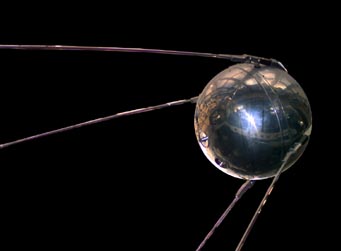
A model of the beachball-sized Sputnik 1 shows its simple construction. The four wire antennas broadcast a simple "beep" tone generated by a battery-powered transmitter. Sputnik 1 remained in orbit only 91 days.
National Air & Space Museum
Where were you on October 4, 1957? That’s the day, 50 years ago, when the Soviet Union launched Sputnik 1, the first artificial satellite. Even though they knew of the Soviets’ plans, American officials found themselves scrambling to track Earth’s new “moon.” A worldwide network of tracking cameras wasn’t ready yet, but dedicated teams of amateur astronomers — organized by the late Fred Whipple under Project Moonwatch — were.
To compute the satellite’s orbit, scientists needed to know where and when it crossed the sky from multiple locations. So each Moonwatch team created an “optical fence” along the celestial meridian, with up to a dozen observers using low-power, wide-field telescopes like the one shown here. At one point, the project had enlisted about 5,000 volunteers and 230 teams worldwide.
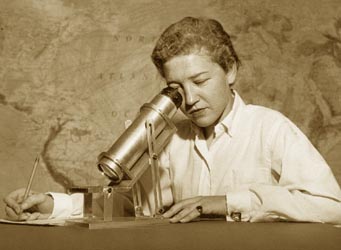
A typical Moonwatch telescope used a mirror to reflect skylight upward into the objective. This arrangement allowed the observer to view the sky comfortably for hours at a time. Using simple aluminum rails, the aimpoint in the sky could be quickly adjusted.
Smithsonian Astrophysical Observatory
When the Moonwatch program finally ended in 1975, it still boasted more than 100 active teams. More importantly, the effort represented a unique collaboration uniting amateur and professional astronomers at the dawn of the Space Age. Christine Pulliam chronicles the program's success — and the initial opposition of some officials to using amateur volunteers — in the October 2007 issue of Sky & Telescope.
Did you participate in Project Moonwatch? Do you own one of these rugged little telescopes? If so, we'd like to hear from you. Send us your recollections and pictures, and we'll post them here. Some readers have already responded; their stories are on the next pages.
A Cookout to Remember
On an evening in late October 1957 my wife and I were invited to a neighbor's home for a cookout. There was a lovely view of a clear sky, with downtown Philadelphia in the distance. After sunset I suggested that we look for the Sputnik, which should be visible that evening. Right on schedule, the bright carrier rocket arched over the southern horizon.
The evening was so clear that I suggested to my neighbor that we should continue to watch for the satellite itself, which was about 25 minutes behind the big carrier rocket. I thought it might pass close to the zenith, so we lay in deckchairs, and, at the appropriate time my neighbor spotted a tiny speck of light high in the sky almost overhead.
Sputnik was still news, so I looked in the next morning's newspaper for any mention of the visibility of the satellite, but there was none. I then called a local observatory, and spoke with the professional who had led a Moonwatch group. He said they had not seen the satellite. When I told him what we had seen, he said "Well, that time is right, but the position is wrong. The satellite is in the same orbital plane as the rocket, so it could not have been overhead". I replied that I thought the rotation of the Earth in the 25 minutes that had passed after the carrier rocket was visible should bring the orbital plane up near the zenith.
His response was. "There's another telephone ringing here that I have to answer."
Gerard M. Foley
New York, NY
"Laika's Fine"
Boy, did your October 2007 issue bring up old memories. I can remember as a young teenager taking the MTA (mass transit) into Cambridge [Massachusetts] from Waltham to participate in a Moonwatch session at Harvard Observatory. Has it been 50 years? They have passed all too quickly.
Little did I know then that the influence of this experience would take me on a lifetime profession as a mechanical engineer. I retired from this profession on 1 August of this year.
_m.jpg)
Jim Cook made his Moonwatch telescope using optics from Edmund Scientific.
Jim Cook
I can still remember sitting in the stairwell at the observatory that night when Sputnik 2 was launched with the dog Laika. We couldn't find it. We were up all night still no observation. As a last resort an announcement went out to the general public over the local radio station. As we waited and watched telephone calls started to come in and someone put it over the speaker. There were several strange calls that we could eliminate immediately.
But suddenly a lady called who knew her exact latitude and longitude, the exact time when she observed the moving dot of light, and the background constellations that the light traveled through. This was a fantastic observation. That what we thought until the woman explained just before hanging up that she took her opera glasses out and checked. She said she could see Laika in the window, and the dog was all right.
Jim Cook
Agawam, MA
The Silent Observation
Our telescope had a little built-in reticle. So when Sputnik went by, you beeped at the start, and you beeped in the middle, and then you beeped when it left … so that they could get the timing.
Since I was new, I worried about, "Oh what if it's a bird, and I beeped? Or what if it was an airplane, and I beeped?" On October 12th, the night we first spotted Sputnik from Cambridge, the most dramatic thing of all was that when I did see it, I kind of choked up. I sat up there with my beeper, thinking "Is that it? Nobody's beeping. Oh, it must not be it. Okay. … Oh, I think that is it. I'll remember, and I'll record it."
So, finally, it left my field of view, and I waited, and nothing happened. And then all of a sudden, all you heard on the roof was: "Beep! Beep! Beep! Beep-beep-beep-beep!" And I said, "Oh no! That was it! All the other people are beeping!"
Afterward, we had a briefing session. Marshall Melin went to the board to show what everybody did, whose observations were recorded, and he said, "And now we'll go to Anna's silent observation." But that's okay, it worked out. They were able to figure it out because I had my piece of paper.
Anna Hillier
Watertown, MA
Too Little Sleep
I was 17 at the time, and I'd begun freshman classes at Northeastern University the month before. Our team had practiced and practiced the observing routine, testing out the microphones, reel-to-reel tape recorders, raising WWV time signals, making believe one of us saw the first satellite, which was supposed to be Vanguard 1, the 6-inch "grapefruit."
On Friday night, October 4th, I had taken the subway to Harvard's Observatory Hill. As I entered the side door to Building D, one of the members shouted, "Paul, the Russians have launched a satellite! They call it 'Spoot-nyick.'"
When we heard it was in a high-inclination orbit we stayed up all night and got the station ready. Eventually we learned that the first passages would be in the early morning, so we sat at our telescopes under the cloud-filled sky. Press photos were taken, observer comments recorded, and we saw nothing.
That night, Saturday, we re-convened after a few hours of napping. I believe it was John McCaig, our club secretary, who brought in his shortwave receiver and set it up on a desk and stretched out a long antenna outside — probably 100 feet long. At the appointed frequency and crossing time, we heard the "beep-beep-beep" of Sputnik's tracking beacon, and we heard it again about 96 minutes later.
A few days later we heard that the team in Peoria, Illinois, was the first to see both the satellite and booster stage. The satellite was about 7th magnitude and the booster about +1. Finally, after eight days of bad weather, on Oct. 12th, the skies cleared overnight and Anna Hillier made the first official New England Observation. I heard her shout it out and gave a description of the trajectory in her field of view. Shortly, thereafter, another member reported the rocket body had passed.
My turn came on October 14th, but just for the booster — I never saw the actual satellite. Just a few weeks later, on November 4th, Sputnik 2 was launched and I made several observations of it.
After an early-morning observing session, I would take a nap on the stairs leading to the roof. The radio telescope was not there then. At 8 a.m. I would get back on the subway and groggily stagger through a day of classes. One of my professors asked why I was so tired. I showed him a Moonwatch scope that was under construction and explained my nocturnal activity. He suggested that I wait until after graduation before tackling such an absurd hobby, but I paid little attention to him.
Sadly, my Moonwatch scope was stolen in 1963.
Paul Valleli
Burlington, MA
A Transforming Experience
I was part of the Danville, Illinois, Moonwatch team, and we were practicing our drill in the days before Sputnik was launched. When we first heard the news, it was tremendously frustrating that we couldn't observe it for some time because of its orbit. But we eventually spotted it and saw most of the other early satellites. It was hard work getting up long before dawn, sitting at the telescope in the cold listening to the time signals from WWV beeping away, and then going to school, but we did it. Observing evenings was a huge pleasure compared to those cold mornings. We called in a lot of observations.
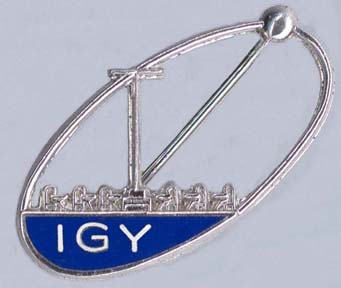
Participants in Project Moonwatch who successfully observed a satellite were given this commemorative pin. It depicts a row of observers, the T-shaped calibration mast, and an orbiting satellite. "IGY" stands for International Geophysical Year."
John Flavin
I kept my telescope for many years, but eventually I used the lens and mirror for other projects and gave the eyepiece to a young amateur astronomer down the street. The only keepsake I have from those days is a little silver lapel pin. It shows a line of telescopes and a central mast enclosed in an elliptical orbit. I wear it every time I put on a suit, but no one ever asks what it is — so I have to tell them.
It would be an interesting study to track down high-school students who were in Moonwatch teams and see how it affected them. David Morrison was a leader of our team, and he and I both became professional astronomers, although we were both excited about astronomy and members of the Danville Astronomical Society before Moonwatch. I've lost track of most of the of the team. I think Moonwatch probably created quite a few scientists, science teachers, and engineers. It was an exciting time.
Thanks for the article. It was fun to go back.
Mike Seeds
Franklin & Marshall College
Lancaster, PA
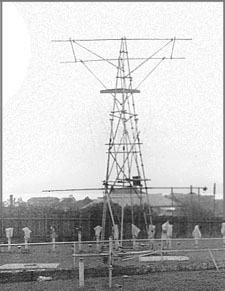
The Sydney Amateur Astronomers used this scaffold to align their Moonwatch telescopes (seen covered along bottom).
John Flavin
Moonwatch "Down Under"
For the past year I have been the archivist for the Astronomical Society of New South Wales and have recently been looking up old copies of our Society journal, Universe to see what we were doing at the dawn of the Space Age — 1956/57. At that time we were a very new group, having been founded in late 1954, (we were then known as the Sydney Amateur Astronomers). Our first big project was to become accredited and actively involved in the Moonwatch project — we like to think that we played our part in the project.
We erected a mast made from scaffolding which had two parallel bars at the top, my understanding is, these bars formed a "reticule" across which hopefully the satellite would be seen to pass through the field of view of the 20 elbow telescopes set up either side of the mast, as seen in the picture. We no longer have members who were there in those early days.
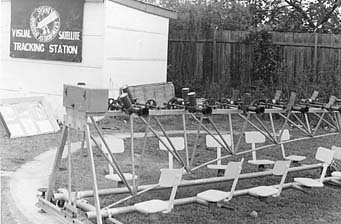
In 1959 members of the Sydney Amateur Astronomers created this setup for their Moonwatch station. The telescopes are mounted on a swinging arm that can be adjusted in azimuth.
John Flavin
My understanding is that the mast was set up in anticipation of a basically east/west satellite passage. As you well know, the big power rivalry at the time saw the Russian satellite up first and this resulted in some hurried realignment of the mast and telescopes.
Eventually about 1959 we set up more versatile arrangement where the elbow telescopes were mounted either side of a swinging arm — this picture gives a good view of the setup. None of the telescopes survive, however; I only have these pictures.
John Flavin
Sydney, NSW, Australia
Moonwatch Card
In 1957 I was a 13-year-old 8th grader who, because of my knowledge of the sky, was invited to join Moonwatch IGY Station 109-034-119 in Santa Monica, California.
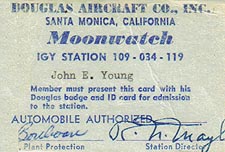
When just 13 years old, John Young was issued this official-looking card so he could participate in Moonwatch activities on the grounds of Douglas Aircraft in Santa Monica, California.
John E. Young
Because it was on private and sensitive Douglas Aircraft property, I was given a temporary Douglas badge. I was invited to join by the Moonwatch director, Dick Mayhew, who, along with my dad, Edward J. Young (Asst. Director) went out to the desert with me for star parties. In our communications to the Smithsonian Observatory, I was able to indicate the observed position of Sputnik relative to named or otherwise identifiable stars.
One unique, I think, benefit of having that card was when, in college prior to obtaining a credit card, it served as a secondary ID when I cashed personal checks. I was amused that the official-looking number on the card was only that of the IGY station and the latitude and longitude of my hometown. But was dutifully noted on my check along with my driver license number.
I still possess two of the scopes, and am always asked what they represent. Moonwatch was a memorable experience, and I'm sadden by the fact that all who were involved with me have passed away. It was a great article and brought back many fond memories.
John Young
Rancho Palos Verdes, CA
Moonwatch in New Zealand
I was born in London on the 4th of October 1938, so Sputnik 1 was launched on my 19th birthday. I flirted with astronomy in my pre-teens and more seriously in mid and late teens with "real" astronomy magazines. I emigrated to New Zealand in 1962, and from there I moved to Invercargill in 1965 where I joined the Southland Astronomical Society. It was there that I met Geoff Hall-Jones.
On Geoff's insistence I participated in setting up a Moonwatch site in Invercargill, the one farthest south supposedly (in those days) at approximately 46.5° south and 168.4° east. I built a shortwave radio to receive time signals from WWVH or WVH, I think it was.
Moonwatch Headquarters supplied ephemerides on satellites that would pass within sight of our base and which we would time against a bright star. The stopwatch was started on the closest previous time signal to reduce errors for the timing. A "running correction" was applied to the stopwatch time, the star identified and the data recorded. Geoff would submit the night's data to Moonwatch Headquarters at the end of the night's observing, and this data was used to correct the orbital empheris held by NORAD/SAO.
I worked with Geoff until late 1967 when I had to return to England for personal reasons. Just before I had to leave, Moonwatch H/Q stated that we were one of the more accurate sites and as we were so far south we were also a important site. For these reasons they were sending a Schmidt-Cassegrain camera to further improve the quality of our sightings. Unfortunately I had to leave before the Schmidt arrived.
Phil Hickford
Nelson, New Zealand
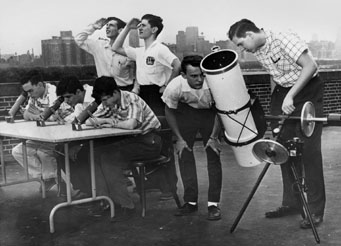
Members of the Chicago Junior Astronomical Society practiced in 1958 on the roof of Adler Planetarium. Seated (from left) are Richard Horwitz, Steve Zarlenga, and Steve Iverson. Standing (from left) are Jim Caplan, Frank Klicar, Paul Lind, and Richard Monnier.
Richard Horwitz
Chicago's Finest
Your Moonwatch article brought back the memory of Sputnik 2 tumbling
and flashing over the Chicago skyline, a spectacular sight
permanently etched in my mind and not diminished by 50 years.
The Moonwatch team of the Chicago Junior Astronomical Society used to observe from the roof terrace of the Adler Planetarium. We got back together for a reunion last August (noted in Sky & Telescope's Letters to the Editor, June 2007).
The Moonwatch telescopes were set up to cover a wide range of sky so
that we were sure at least one of us would see the satellite. I was never one of the lucky ones. But it sure was fun trying.
Richard Horwitz
Somerset, NJ
The Early Years
I was 17 years old then and recently graduated from high school. I was in my first year at a local college and wanted to pursue some scientific or engineering degree, although I was at that point pretty unsure about what I wanted to do about anything.
I recall seeing the Moonwatch telescopes, but I never actually owned one. I did, however, build my own 4.25-inch reflector telescope and learned basic astronomy from using that device. I recall watching the sky looking for Sputnik, but I can't recall ever having seen it; it was, after all, a very small object and I lived in a rather light-polluted part of town.
Although the US launched Explorer 1 just 3½ months after Sputnik it seemed like an eternity passed before "our side" got into the Earth orbit game. This, of course, was after one or two failed Vanguard launch attempts. What a feeble program Vanguard turned out to be, but it was deemed to be politically desirable by the Eisenhower Administration not to have a military rocket send a satellite into orbit.
Just 3½ years after that Alan Sheppard was the first American into space atop one of the Army's Redstone rockets. I recall listening to the launch and recovery while getting a haircut at Harlingen Air Force Base, Texas. I was training to be an Air Force navigator. Yuri Gagarin had orbited Earth a month before, so Sheppard's suborbital flight didn't seem like much at the time. Still it was progress. Nine months after that John Glenn orbited Earth after being launched by another military rocket, an Atlas.
Gerald P. Hanner
Papillion, NE
Thank You, Mrs. Hefferan
I was an early member of the Moonwatch team that operated out of Albuquerque High School in Albuquerque, New Mexico. It was coordinated by Mrs. Viola Hefferan. She was actually our World History teacher, but was the only teacher who had any interest in the little article we saw asking for amateur teams to observe the Sputnik satellite. She had no scientific background but believed in teaching and encouraging students when they wanted to learn. By Christmas we were equipped and functioning as an official Moonwatch team.
Initially we had no telescope equipment whatsoever. So Mrs. Hefferan approached the president of one of the local banks to fund the project, which he did. We then got the machine shop at the school to build a large frame to hold the telescopes. I don’t recall where the telescopes were made. The school had a radio station on the roof of the main building, which was three stories high, and we did all our observations from the roof of this building.
One of the student radio operators joined our team. He set up an input from the WWV time station and set up buzzers from each of the telescope locations so that we could buzz the satellite as it crossed in front of two different stars in our field of view. This gave us exact time and location from our position on Earth. We also bought celestial charts that we used to mark the grid across the sky with the grid overlapped so that at least two telescopes saw each pass.
Since Albuquerque had 365 cloudless nights each year and we went out for every satellite pass, we had a very high record of sightings. Each of us watched satellite passes all night and went to school the next day for three years and through several satellites. The proudest day any of us had in high school was when we were awarded our pins for participation in the IGY.
Mrs. Hefferan dropped us off the team for a month if our grades went down so we all maintained at least a B+ average. We were locked out if we showed up late, even if the meeting time for observation was at 2:00 a.m. — so no one was ever late. Mrs. Hefferan always said the satellite didn’t take excuses. My mother was the main parent willing to drive us in to the high school in the middle of the night, so she always picked up a car full of kids. She slept in the car while we watched the satellite then drove us home. She worked full time and I was an adult before I realized how hard this must have been for her. I was the only girl on the team, which I assume was part of her motivation.
Of those I remember who were on the team, one of our original student team leaders was killed in Vietnam. Two of us went on to run companies in the electronics industry. One of the team members won the Westinghouse Science Talent Search as a senior and was awarded a full four-year scholarship to a top university. Another went to the Air Force Academy, became a doctor, and ran a major hospital before retiring. I had an undergraduate scholarship and a Ford Foundation Fellowship for graduate studies in physics and have written several books in the semiconductor field.
I’ve lost track of the others, but I assume they also did well. This is not a bad track record for what was the “vocational” high school in Albuquerque at the time. The other high school served mostly the children of military personnel stationed at Kirtland Air Force Base and scientists working at the Sandia Labs. They had the money, but they didn’t have Mrs. Hefferan.
Betty Prince
Leander, TX
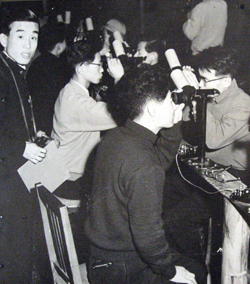
Members of the Moonwatch team at Hiroshima University during a pass of Sputnik 1 in 1957.
Takeshi Sato
Moonwatch in Japan
I was born on March 15, 1938, and was a member of Hiroshima Moonwatch Team. At the time of Sputnik 1, I was just 19 years old and a “2nd grader” of the university’s Faculty of Pedagogy.
The team's observing station was located at a branch of Hiroshima University and operated by students under Tadayoshi Murakami, who at that time was an associate professor.
Our station had 10 Nikon telescopes, each with a 45-mm objective lens, 5.5× and 11° in field diameter. Those telescopes covered the meridian from horizon to horizon.
Unlike the photograph and illustration on page 33 of the October 2007 issue of Sky & Telescope, our station had no mast for aligning on the sky.
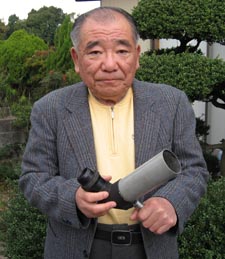
Takeshi (Ken) Sato with the Nikon telescope that he used 50 years ago during Project Moonwatch.
Takeshi Sato
Each telescope had two parallel bars in the field of view, and the center between those bars showed the position of the meridian. I've included a picture of me holding my scope.
Takeshi (Ken) Sato
Hiroshima, Japan
 0
0
Comments
You must be logged in to post a comment.